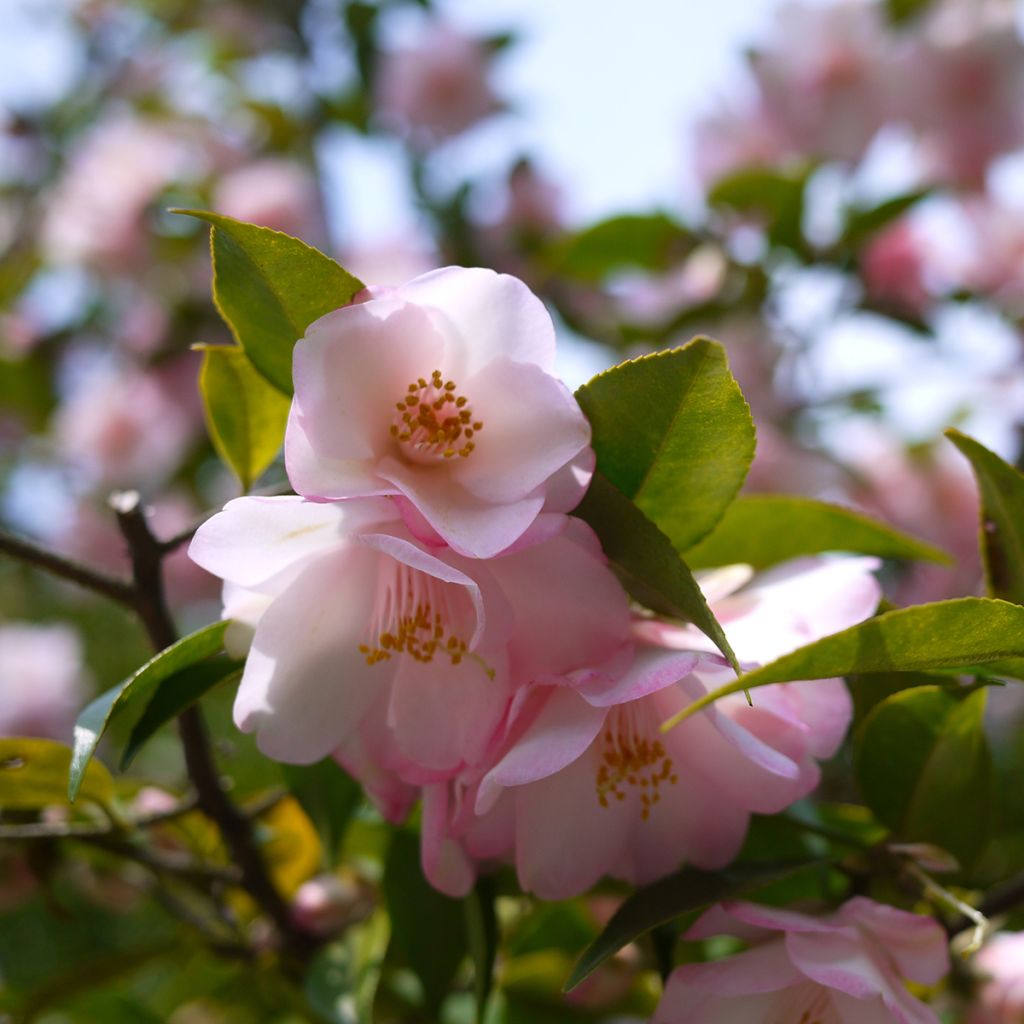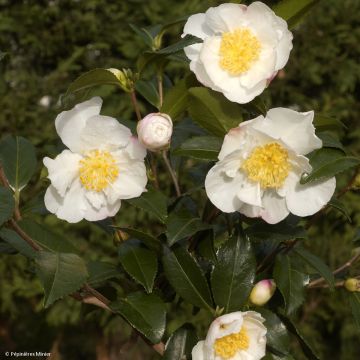

Camellia transnokoensis Transtasman


Camellia transnokoensis Transtasman


Camellia transnokoensis Transtasman
Camellia transnokoensis Transtasman
Camellia x transnokoensis Transtasman
Special offer!
Receive a €20 voucher for any order over €90 (excluding delivery costs, credit notes, and plastic-free options)!
1- Add your favorite plants to your cart.
2- Once you have reached €90, confirm your order (you can even choose the delivery date!).
3- As soon as your order is shipped, you will receive an email containing your voucher code, valid for 3 months (90 days).
Your voucher is unique and can only be used once, for any order with a minimum value of €20, excluding delivery costs.
Can be combined with other current offers, non-divisible and non-refundable.
Why not try an alternative variety in stock?
View all →This plant carries a 24 months recovery warranty
More information
We guarantee the quality of our plants for a full growing cycle, and will replace at our expense any plant that fails to recover under normal climatic and planting conditions.
Would this plant suit my garden?
Set up your Plantfit profile →
Description
The 'Transtasman' Camellia is a hybrid camellia with small, evergreen glossy leaves in winter. Throughout spring, it produces delicate single, white flowers with a touch of pink. With a moderate size and an upright habit, it can easily be integrated into a partially shaded flower bed, a medium-sized hedge, or even a pot, provided it is given an acidic, rich, and moist but well-drained substrate.
The 'Transtasman' Camellia is a bush belonging to the Theaceae family (even if its relation to tea is not immediately obvious at first glance!). This variety is a hybrid derived from the Camellia transnokoensis botanical camellia, a superb wild species native to Taiwan, specifically from Mount Noko, which gives it its name. Like its parent, Camellia Transtasman has small, lanceolate, dark green, glossy evergreen leaves, measuring about 3 to 4 cm (1 to 2in) in length. From the beginning of spring, in March, this camellia produces numerous pink buds that open into small, slightly asymmetrical, white flowers with a touch of pink, measuring 4 cm (2in) in diameter. A bouquet of golden stamens adorns the centre of the flowers, emitting a light fragrance. The flowering continues sporadically for a long period, sometimes until summer. With its rustic charm, it will satisfy even those who do not appreciate the sophistication of large double-flowered hybrid camellias. With a compact and upright habit, it will not exceed 1.50 to 2 m (5 to 7ft) in height, with a width of 1.50 m (5ft). Like most camellias, 'Transtasman' prefers acidic and well-drained soil, or at least neutral soil, but without limestone, which quickly causes its leaves to turn yellow. It has respectable hardiness and can withstand temperatures as low as -12°C (10.4°F) in a sheltered position.
Like many camellias, 'Transtasman' will be more at ease in an oceanic climate : rainy summers and mild winters are much more beneficial for it than strong continental temperature variations. The modest size and upright habit of this variety make it suitable for solitary planting, as well as in a hedge that does not exceed 2 meters (7 feet) in height. It performs well in pots, allowing you to enjoy it even if your soil is not suitable for acid-loving plants or if your climate is too cold. Combine it with Brunnera macrophylla 'Emerald Mist', Actaea 'Brunette', Hosta Minuteman, or even the rare Calanthe discolor for a beautiful display of wild understory plants. A carpet of ferns like Athyrium niponicum 'Pewter Lace' at its base will also create a beautiful contrast with the flowers.
Camellia transnokoensis Transtasman in pictures


Plant habit
Flowering
Foliage
Botanical data
Camellia
x transnokoensis
Transtasman
Theaceae
Cultivar or hybrid
Other Camellias A to Z
View all →Planting and care
Camellia Transtasman can be placed in a shady or semi-shady spot, in the morning or evening sun, always protected from cold and drying winds. If you cultivate it in the sun (not scorching), the roots should always remain moist. Plant it in a soil that remains damp, humus-rich, acidic, without limestone, and well-drained. The bush should not be planted too deeply, the top of the root ball should be covered with 3 cm (1in) of soil. In winter, cover it with a 5 to 7 cm (2 to 3in) thick mulch composed of leaf compost and crushed bark. Beware of late frosts that can damage the flowers and buds. During dry periods, water the bush to prevent the buds from falling off. Pruning should be done every year after flowering. Lightly prune the stems that prevent the bush from maintaining its compact appearance. Remove faded flowers if you do not want fruit and remove dead shoots. The mature Camellia can withstand severe pruning. The Camellia can be susceptible to rot, leaf spots, and viruses. It can be attacked by aphids and scale insects that cause sooty mold, as well as by weevils.
Planting period
Intended location
Care
Planting & care advice
This item has not been reviewed yet - be the first to leave a review about it.
Similar products
Haven't found what you were looking for?
Hardiness is the lowest winter temperature a plant can endure without suffering serious damage or even dying. However, hardiness is affected by location (a sheltered area, such as a patio), protection (winter cover) and soil type (hardiness is improved by well-drained soil).

Photo Sharing Terms & Conditions
In order to encourage gardeners to interact and share their experiences, Promesse de fleurs offers various media enabling content to be uploaded onto its Site - in particular via the ‘Photo sharing’ module.
The User agrees to refrain from:
- Posting any content that is illegal, prejudicial, insulting, racist, inciteful to hatred, revisionist, contrary to public decency, that infringes on privacy or on the privacy rights of third parties, in particular the publicity rights of persons and goods, intellectual property rights, or the right to privacy.
- Submitting content on behalf of a third party;
- Impersonate the identity of a third party and/or publish any personal information about a third party;
In general, the User undertakes to refrain from any unethical behaviour.
All Content (in particular text, comments, files, images, photos, videos, creative works, etc.), which may be subject to property or intellectual property rights, image or other private rights, shall remain the property of the User, subject to the limited rights granted by the terms of the licence granted by Promesse de fleurs as stated below. Users are at liberty to publish or not to publish such Content on the Site, notably via the ‘Photo Sharing’ facility, and accept that this Content shall be made public and freely accessible, notably on the Internet.
Users further acknowledge, undertake to have ,and guarantee that they hold all necessary rights and permissions to publish such material on the Site, in particular with regard to the legislation in force pertaining to any privacy, property, intellectual property, image, or contractual rights, or rights of any other nature. By publishing such Content on the Site, Users acknowledge accepting full liability as publishers of the Content within the meaning of the law, and grant Promesse de fleurs, free of charge, an inclusive, worldwide licence for the said Content for the entire duration of its publication, including all reproduction, representation, up/downloading, displaying, performing, transmission, and storage rights.
Users also grant permission for their name to be linked to the Content and accept that this link may not always be made available.
By engaging in posting material, Users consent to their Content becoming automatically accessible on the Internet, in particular on other sites and/or blogs and/or web pages of the Promesse de fleurs site, including in particular social pages and the Promesse de fleurs catalogue.
Users may secure the removal of entrusted content free of charge by issuing a simple request via our contact form.
The flowering period indicated on our website applies to countries and regions located in USDA zone 8 (France, the United Kingdom, Ireland, the Netherlands, etc.)
It will vary according to where you live:
- In zones 9 to 10 (Italy, Spain, Greece, etc.), flowering will occur about 2 to 4 weeks earlier.
- In zones 6 to 7 (Germany, Poland, Slovenia, and lower mountainous regions), flowering will be delayed by 2 to 3 weeks.
- In zone 5 (Central Europe, Scandinavia), blooming will be delayed by 3 to 5 weeks.
In temperate climates, pruning of spring-flowering shrubs (forsythia, spireas, etc.) should be done just after flowering.
Pruning of summer-flowering shrubs (Indian Lilac, Perovskia, etc.) can be done in winter or spring.
In cold regions as well as with frost-sensitive plants, avoid pruning too early when severe frosts may still occur.
The planting period indicated on our website applies to countries and regions located in USDA zone 8 (France, United Kingdom, Ireland, Netherlands).
It will vary according to where you live:
- In Mediterranean zones (Marseille, Madrid, Milan, etc.), autumn and winter are the best planting periods.
- In continental zones (Strasbourg, Munich, Vienna, etc.), delay planting by 2 to 3 weeks in spring and bring it forward by 2 to 4 weeks in autumn.
- In mountainous regions (the Alps, Pyrenees, Carpathians, etc.), it is best to plant in late spring (May-June) or late summer (August-September).
The harvesting period indicated on our website applies to countries and regions in USDA zone 8 (France, England, Ireland, the Netherlands).
In colder areas (Scandinavia, Poland, Austria...) fruit and vegetable harvests are likely to be delayed by 3-4 weeks.
In warmer areas (Italy, Spain, Greece, etc.), harvesting will probably take place earlier, depending on weather conditions.
The sowing periods indicated on our website apply to countries and regions within USDA Zone 8 (France, UK, Ireland, Netherlands).
In colder areas (Scandinavia, Poland, Austria...), delay any outdoor sowing by 3-4 weeks, or sow under glass.
In warmer climes (Italy, Spain, Greece, etc.), bring outdoor sowing forward by a few weeks.





































































